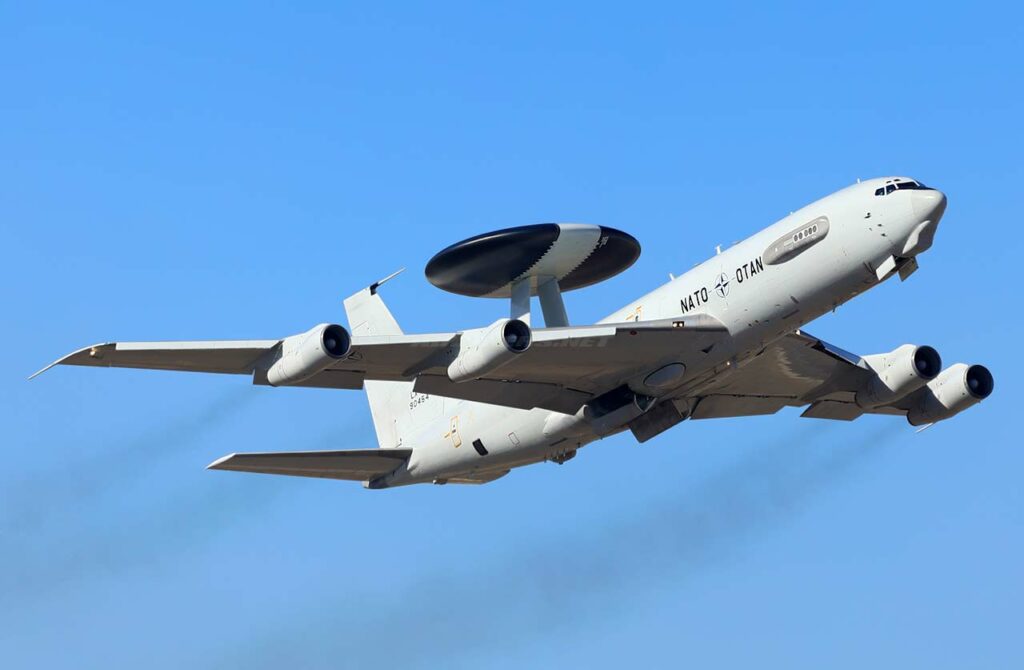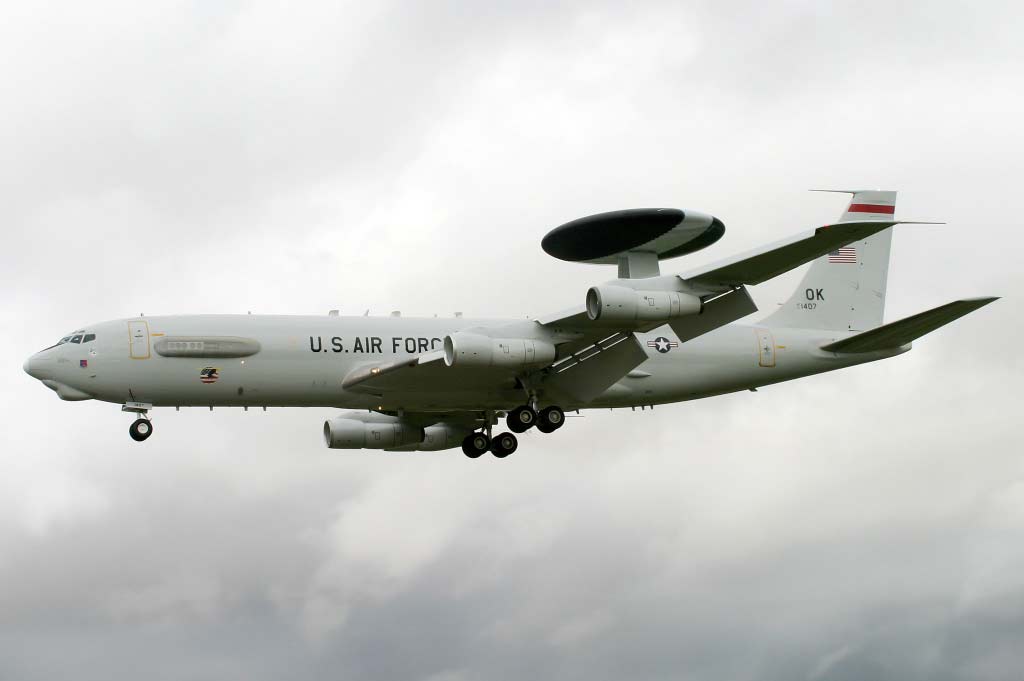E-3 Sentry AWACS: Advanced airborne early warning and control system with 360-degree radar coverage.
In brief
The Boeing E-3 Sentry, commonly known as AWACS (Airborne Warning and Control System), is an American airborne radar surveillance system. It features a distinctive rotating radar dome above its fuselage. Based on the Boeing 707-320 aircraft frame, the E-3 Sentry provides all-weather surveillance, command, control, and communications. Equipped with the Westinghouse AN/APY-1 and later AN/APY-2 radars, it can track air and sea targets simultaneously. The aircraft has a crew capacity of up to 34 personnel, including flight and mission members, and is powered by four Pratt & Whitney TF33-PW-100A turbofan engines. With a maximum speed of about 530 mph and a range of over 4,000 miles, the E-3 can perform flights lasting more than 8 hours without refueling.

History of the Development of the Boeing E-3 Sentry (AWACS)
The E-3 Sentry was developed during the early 1970s in response to the need for advanced airborne early warning and control capabilities by the United States Air Force. This requirement emerged from the experiences of the Cold War, particularly the Cuban Missile Crisis, which underscored the necessity for enhanced surveillance that could command and control a large number of forces while detecting incoming threats at long distances.
The development program was initiated by the USAF in 1968 to replace older EC-121 Warning Star aircraft. Boeing was awarded the contract due to its proposal based on the existing 707 platform, which promised a higher performance and more versatile surveillance capability. The first flight of the E-3 occurred on February 17, 1972, and it officially entered service in March 1977. The deployment of the E-3 Sentry was a significant enhancement in U.S. and NATO air defense capabilities, offering an extensive radar coverage and the ability to manage and monitor air engagements effectively.
Design of the Boeing E-3 Sentry (AWACS)
The design of the E-3 Sentry incorporates several key features that support its mission. The most notable is the 9.1-meter diameter rotating radar dome (rotodome) mounted on two struts above the fuselage. This rotodome houses a large, sophisticated radar array capable of providing 360-degree surveillance, thus able to detect targets at distances of up to 400 kilometers.
The aircraft is built upon the Boeing 707-320 airframe, an approach that leveraged existing commercial aviation technology for military use, ensuring reliability and easier maintenance. It measures 46.61 meters in length, with a wingspan of 44.42 meters, and a maximum takeoff weight of about 147,000 kilograms. The interior is divided into a flight deck and a main cabin that houses the rest of the crew, including radar operators, technicians, and controllers.
The E-3’s radar system is sophisticated enough to track air and sea targets, providing a comprehensive operational picture. The onboard communication systems integrate these findings with data from other sources, improving the command and control capabilities of military operations. The Sentry’s capabilities are, however, limited by its dependency on large ground infrastructure for detailed processing and analysis.
Performance of the Boeing E-3 Sentry (AWACS)
The E-3 Sentry is equipped with four Pratt & Whitney TF33-PW-100A turbofan engines, each providing about 21,000 pounds of thrust. This power allows the aircraft to reach speeds of up to 530 mph (Mach 0.7), with a ceiling of 29,000 feet. Its operational range extends to over 4,000 miles, and it can conduct flights of over 8 hours without refueling.
Compared to other aircraft in the airborne early warning and control role, such as the Russian Beriev A-50 and the British Aerospace Nimrod AEW3, the E-3 Sentry offers a larger radar coverage and more advanced avionics, facilitating better coordination and management of widespread military efforts. This capability has proven essential in various operational scenarios, providing a significant advantage in air warfare.
Variants of the Boeing E-3 Sentry (AWACS)
Several variants of the E-3 Sentry have been developed to cater to different needs and technologies:
- E-3A: Initial production version for the USAF, equipped with AN/APY-1 radar.
- E-3B: Updated systems for improved reliability.
- E-3C: Incorporates AN/APY-2 radar with additional modes and enhanced capabilities.
- E-3D: Variant used by the Royal Air Force, with specific modifications for compatibility with British systems.
- E-3G: The latest upgrade featuring modernized flight systems and electronics.

Military Use and Combat of the Boeing E-3 Sentry (AWACS)
The E-3 Sentry has been a cornerstone of NATO and U.S. air defense strategy since its induction. It has been actively used in numerous conflicts, including the Persian Gulf War, the War in Afghanistan, and operations in Iraq. Its ability to manage large-scale air operations and provide early warning of incoming threats has made it invaluable. The E-3 has directed fighter operations, managed fleet defenses, and supported ground forces, significantly enhancing the effectiveness and safety of military operations.
The aircraft has been sold to several countries, including the United Kingdom, France, Saudi Arabia, and NATO. It continues to be an active element of U.S. and allied military operations, with ongoing upgrades to systems and capabilities ensuring its relevance in modern air defense.
The Boeing E-3 Sentry AWACS represents a significant advancement in military surveillance and command and control capabilities. Its comprehensive coverage, advanced radar and communication systems, and the ability to control a vast array of military assets in real-time have established the E-3 as a critical component of national and international security measures. Despite facing challenges such as operational costs and technological obsolescence, the continued updates and strategic use underscore its enduring value and effectiveness.
Back to the Spy Planes section.